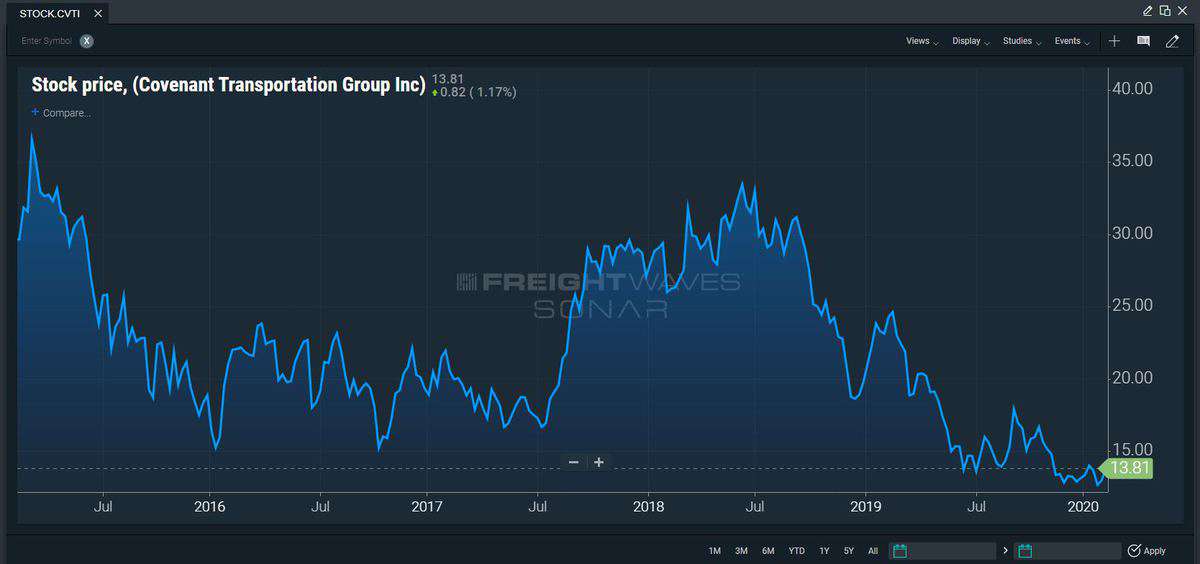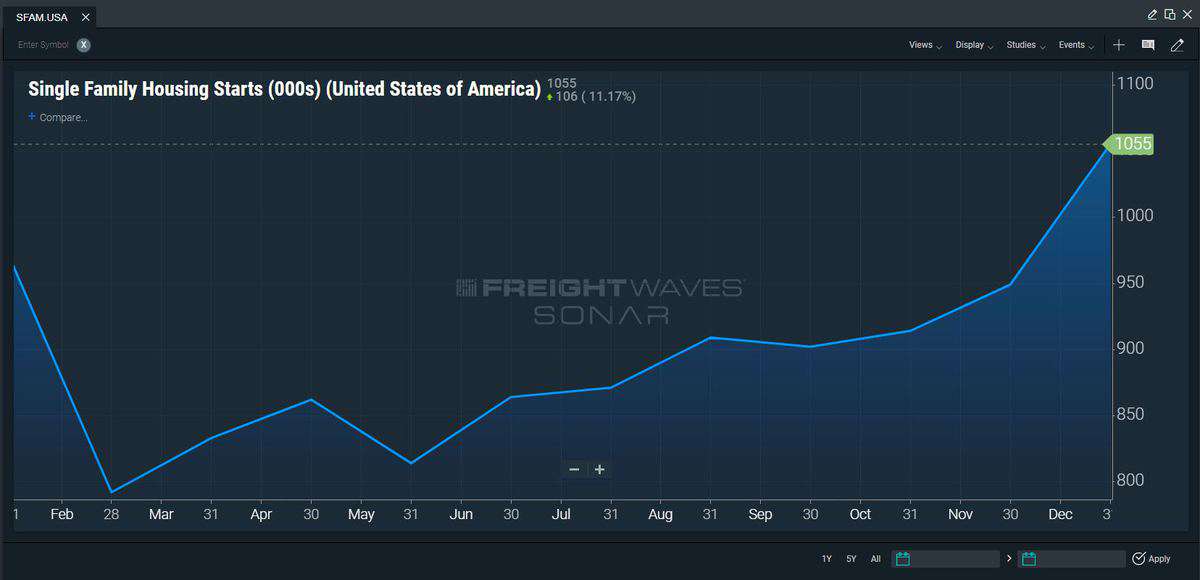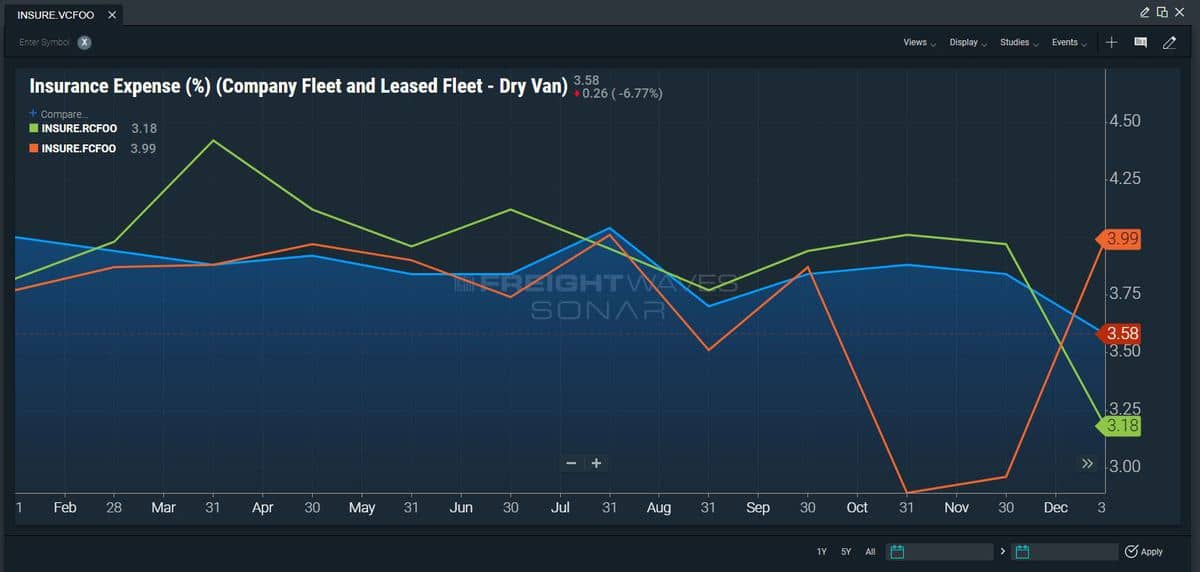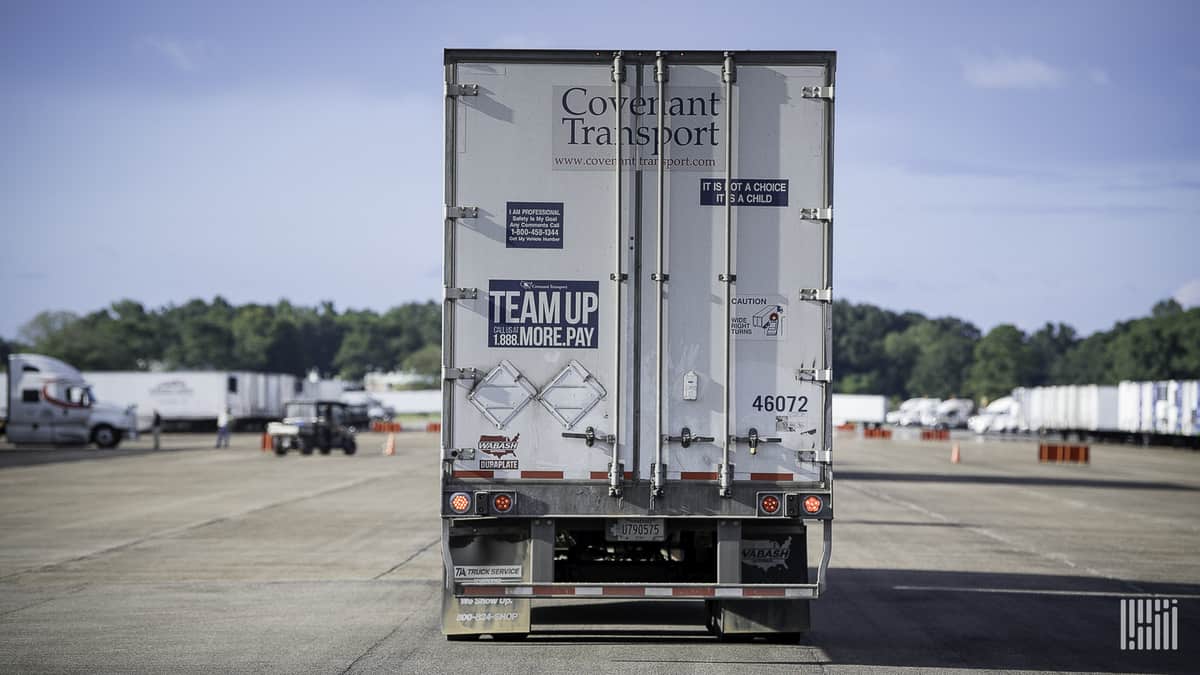A new capacity crunch is coming to the industry very soon, and that is a very good thing for rates and an industry that is struggling with an overcapacity situation. That is one of the takeaways from a conversation on Thursday with Joey Hogan, president and COO of Covenant Transport (NYSE: CVTI), at the ACT Research Seminar 62 conference in Columbus, Indiana.
Hogan was joined by Kevin Burch, president of Jet Express, as the duo discussed a range of topics from the economy to safety with Tim DeNoyer, vice president and senior analyst at ACT Research.
“From a capacity standpoint, I can paint a picture that it’s going to get really bad in April, the middle of May,” Hogan said. To illustrate, he pointed to the timing of the coronavirus that shut down factories in China right after Chinese New Year had already shuttered facilities. The shutdowns have slowed goods movement from that country.

Hogan also pointed to the importance of May 15. That date represents the start of produce season in California. The possibility exists that a capacity surge from the ports could coincide with produce season, straining the supply chain. Carriers will be feeling pressure from all sides — strong housing starts, an economy that is humming along and regulatory pressures from the Drug & Alcohol Clearinghouse and the increase in the random truck driver drug testing rate to 50% this year.

“We think there is going to be some capacity shortages in March or April,” Hogan said.
“I think it’s going to jump from an over[capacity situation] to under very quickly,” Hogan answered later in response to an audience question. “I don’t think there will be an in-between.”
Burch, whose fleet runs automotive parts for the Detroit automakers, focused much of his discussion time on the image of the industry. A former chairman of the American Trucking Associations, Burch relayed several stories, including the time he was cut from a career day at a high school. He now wears an I heart trucks button everywhere he goes.
“I’ve been wearing the I heart trucks button for about 10 years,” he said. “People ask, ‘Why do you do that?’ It gives me an opportunity to talk about trucking.”
Burch said the industry needs to tell its story more often. To illustrate, he said that 10 years ago, he was speaking to a group of about 100 people and asked them to raise their hands if they would promote the industry to their children. “One and a half people raised their hand,” he said. “I say a half because one woman wasn’t sure she wanted to raise her hand. I knew then we had an image problem.”
Fifteen years later, after he was rejected at that career day, Burch was back at the same school and following his presentation, the students voted trucking the second-best career option out of more than 100 presented, he said.
Turning to topics of immediate concern to the industry, both men expressed frustration with insurance rates.
“Insurance is a disaster. It’s a bloody disaster,” Hogan said. “And shippers out there, we need your help. Carriers can’t afford $25,000 a truck, which is what some carriers are getting quoted. They can’t afford $25,000 – some trucks only make $25,000 a year.”

Wages and the lack of drivers also are hot-button issues. Both said there is a driver shortage, despite some who claim the driver shortage is merely an economic problem.
“In 2018, most carriers didn’t do one or two pay increases, they did three or four and then in 2019 things settled down,” Burch said. “But when things pick up again, we’re going to need drivers. We’ve got a good story to tell.”
The driver situation is compounded by the average age of truck drivers in this country: 52. The average age of all U.S. workers is 42, confirming that trucking is having a problem luring younger generations to the job. Burch and Hogan are advocates for allowing 18-year-olds to drive interstate trucks.
“We shouldn’t have state lines that act as an inhibitor for drivers,” Burch said.
The Federal Motor Carrier Safety Administration (FMCSA) had been working on a proposed rule to allow 18-year-old CDL holders to cross state lines. CDL holders can drive intrastate at 18 but not interstate.
“The industry is saying, ‘If you can drive intrastate, why can’t you drive interstate?’ That’s all trucking is asking,” Hogan added.
Burch noted the random drug testing rate, which is now at 50%, and the impact it may have, especially as more states legalize marijuana, which remains an illegal substance for truck drivers who work under federal regulations.
“We want professional people behind the wheel and it’s why with 17 states [legalizing marijuana], you are seeing more [positive tests for] marijuana,” he said.
The FMCSA proposal that would introduce sleeper berth flexibility was praised by Burch and Hogan.
“Once you log in, your clock starts and you can’t stop it, and you have 14 hours to drive 11, and you’re also limited by the 70- and 80-hour rules,” Hogan said. “Who can imagine working 70 hours for 52 weeks straight? What fuels churn? It’s a tough job. We’re not trying to add to the 70 or 80, we don’t want to add hours.”
Burch added that the current hours-of-service rules and the tighter controls that have resulted from the electronic logging device rule have made truck parking worse.
“As we get tighter with the hours of service, and we’re going to mandate our drivers’ hours, don’t you think we need to give them a place to park?” he asked.
Neither executive wanted to wade too far into the AB5 regulation dominating the news in 2020, but Burch did praise owner-operators.
“I consider the owner-operators the backbone of the industry, and there is a need for them,” he said, noting that 90% of the industry operates six trucks or less. “I would say there will continue to be owner-operators. Maybe there will be some push to make them employee drivers or to change the tax laws or eliminate [or add] some deductions.
“We can’t have different work rules in different states,” he added.












DPP
The president and COO of Covenant Transport is quoted in this article stating that drivers work under a 6/70 or 7/80 clock, which is incorrect. Drivers CAN work 60 hours in 7 days or 70 hours in 8 days. So a typical OTR driver can log only 8.75 hours of combined driving and on-duty-not-driving time on a continual basis (8 days x 8.75 work hours). That is not unreasonable. Commonly misstating this as a “70-hour-work-week” makes the public believe we’re all over-worked already; we are not. For Hogan to misstate this as 80 hours or “70 hours for 52 weeks straight” is dangerously stupid.
CM Evans
I don’t completely disagree, your math is correct. I get the hunch there is another underlying message your trying to convey. I’ve used this formula myself and I think a different approach in using it is to associate it to a planning tool as guidance to gain efficiency.
Sean
It’s great that we have so many people that are so smart and In this industry As sit behind a desk all day talking about what they learned on there laptop Personally I think get away from your desk go get in the truck go out in the road for 30 days then come back to me and tell me what the true problem is already tired the true problem is we the willing who are led by the annoying are asked to do the impossible for the On grateful for we have done so much for so long that we can accomplish just about Anything with nothing
Michael Miles
The federal government needs to stay out of it. Every time they interfere, they make it worse when it comes to the hours of service. They do need to crack down on these trucking companies falsafying dak reports. The industry wants to attract younger drivers. They need to give more and better home time. There are fewer dedicated and regional driving jobs. There is not a shortage of drivers.
Charles Colee
As a 43 year veteran of the industry, I have to say that trucking has a long way to go in order to attract quality applicants. Long story short, you get what you pay for. And considering the hours we put in, and the many miscellaneous aggravations we’re forced to deal with just getting the job done, it sure ain’t paying enough.
Michael Watson
Someone please explain to me as a 6yr otr driver with no accidents,perfect driving record,and an exceptional csa score,how companies that hire owner operators under contract and 1099,can all of a sudden start demanding random drug test to drivers that are not only 1099,but legally aren’t employees of that company,if their able to do that,then the 1099 status needs to go bye bye,or the need to be legally held accountable.
Tony
Automatic transmission in trucks.
Give me a manual transmission any time. You have more control with a manual transmission than you do with an automatic transmission. One example backing into a dock with an automatic transmission. How many of you drivers ramed a dock ? In snow what kind of control do you have. Getting stuck in snow. 9 out of 10 times you can free yourself being stuck with a manual transmission than you can then with a automatic transmission have to call a wreck to pull you out. The reason why company’s are buying automatic transmission is because the young drivers never drove a manual transmission. Ask them if they know how to double clutch and there using the clutch pedal for a foot rest and the company’s have to get the clutch repaired. Sorry but I’m a manual transmission driver and have been for 44 years.
Goodtimes
Ill be damned. SO you can run the coast of California 480 miles at 18 but need to be 26 to cross the river out of St Louis to Illinois? I had 500000 by the time I was 25. You cant legislate common sense at any age,
Liberty88
We don’t have a driver shortage – we have a pay shortage. The Global shippers are unwilling to pay. Also the top fleets in size get MASSIVE subsidies for fuel, driver training, tax breaks, etc. That doesn’t make it to the professional drivers. 18 year old driving interstate?! Hell, no. They don’t have the maturity to do that. Just another means of keeping wages supressed.
Driver wages, for the hours committed. should be at least $100,000/year.
Been driving 28 years. Sick of dot regs that get more cowardly by the year. One of our guys got a citation for not having his snitch box (electronic log indicator lights) attached to the dash incorrectly. Stupid.
No one is getting cited for cutting in front of trucks, passing on right, running off road LED’s at night… No one is cracking down on the thousands of overloaded homeowner utility trailers with no taillights – but have one brake light, marker light out on a CMV?! WELL THATS CALL FOR A FULL INSPECTION!!
Sean
Get rid of DE regulation and start regulating the freight and will all make a h*** of a lot more money and The seats that are empty will be filled with people that want to make good money